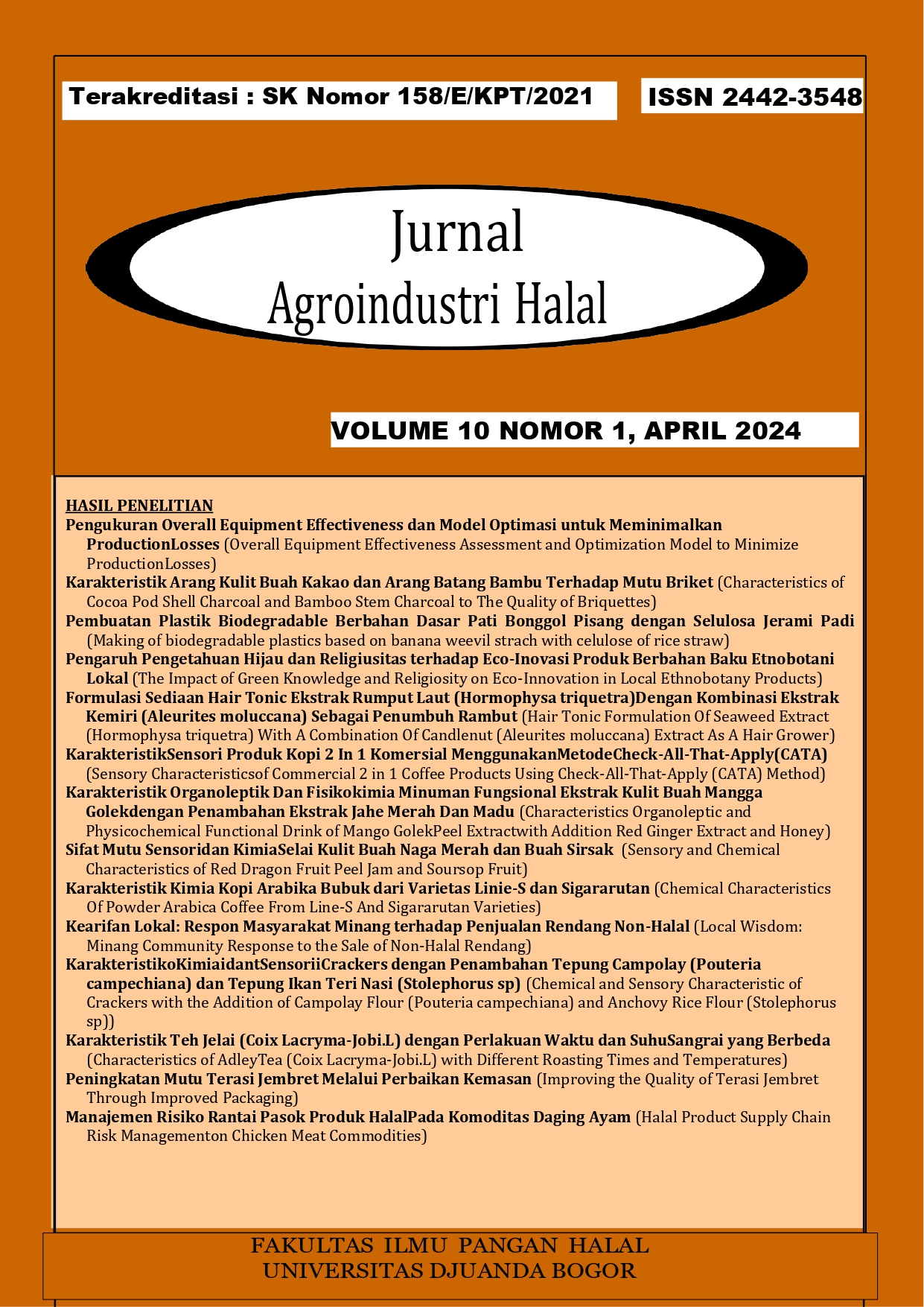Pengukuran Overall Equipment Effectiveness dan Model Optimasi untuk Meminimalkan Production Losses
Main Article Content
Abstract
The overall equipment effectiveness assessment (OEE) result on the rollwrap machine at Sugar Candy Co.Ltd reached 69.1%. This OEE result needs to meet the requirement of companies that apply OEE values above 72.5%. The Purpose of this research is to analyze the effectiveness of the roll wrap machine and identify the cause of its ineffectiveness of the machine. Besides, this study also uses a fuzzy inference system to classify the variables of downtime losses, frequency of speed losses, and OEE into linguistic variables to make it easier for operators to identify machine status. Improvement plan with a proposed quantitative approach using goal programming by minimizing deviational variables at low, medium, and high OEE status frequencies. The research results show that unscheduled machine maintenance reduces machine performance and is the main factor causing low machine availability. There were nine fuzzy rules for the machine OEE status inference process at high, medium, to low-status levels. Based on the calculation of goal programming, to achieve the OEE target above 80% within 30 working days, The OEE status must achieve the high level at least 20 times. The machine can achieve OEE with a moderate level eight times, and a low level occurs a maximum of two times.
Article Details

This work is licensed under a Creative Commons Attribution-ShareAlike 4.0 International License.
Authors who publish with Jurnal Agroindustri Halal agree to the following terms:
- Authors retain copyright and grant the journal right of first publication with the work simultaneously licensed under a Creative Commons Attribution 4.0 International License that allows others to share the work with an acknowledgement of the work's authorship and initial publication in Jurnal Agroindustri Halal.
- Authors are able to enter into separate, additional contractual arrangements for the non-exclusive distribution of the journal's published version of the work (e.g., post it to an institutional repository or publish it in a book), with an acknowledgement of its initial publication in Jurnal Agroindustri Halal.
- Authors are permitted and encouraged to post their work online (e.g., in institutional repositories or on their website) prior to and during the submission process, as it can lead to productive exchanges, as well as earlier and greater citation of published work
References
Abdelbar, K. M., Bouami, D., & Elfezazi, S. (2019). New approach towards formulation of the overall equipment effectiveness. Journal of Quality in Maintenance Engineering, 25(1), 90–127. https://doi.org/10.1108/JQME-07-2017-0046
Afefy, I. H. (2013). Implementation of total productive maintenance and overall equipment effectiveness evaluation. International Journal of Mechanical & Mechatronics Engineering, 13(01), 69–75.
Almeanazel, O. T. R. (2010). Total productive maintenance review and overall equipment effectiveness measurement. Jordan Journal of Mechanical and Industrial Engineering, 4(4), 517–522.
Annamalai, S., & Suresh, D. (2019). Implementation of total productive maintenance for overall equipment effectiveness improvement in machine shop. International Journal of Recent Technology and Engineering, 8(3), 7686–7691. https://doi.org/10.35940/ijrte.C6212.098319
Brodny, J. (2019). Analysing the Utilisation E ff ectiveness of Mining Machines Using Independent Data Acquisition. Energies, 1–15.
Djatna, T., & Munichputranto, F. (2015). An analysis and design of mobile business intelligence system for productivity measurement and evaluation in tire curing production line. Procedia Manufacturing, 4(Iess), 438–444. https://doi.org/10.1016/j.promfg.2015.11.060
Fajrah, N., & Noviardi, N. (2018). Analisis Performansi Mesin Pre-Turning dengan Metode Overall Equipment Effectiveness pada PT APCB. Jurnal Optimasi Sistem Industri, 17(2), 126–134. https://doi.org/10.25077/josi.v17.n2.p126-134.2018
Gupta, P., & Vardhan, S. (2016). Optimizing OEE, productivity and production cost for improving sales volume in an automobile industry through TPM: A case study. International Journal of Production Research, 54(10), 2976–2988. https://doi.org/10.1080/00207543.2016.1145817
Jauregui Becker, J. M., Borst, J., & Van Der Veen, A. (2015). Improving the overall equipment effectiveness in high-mix-low-volume manufacturing environments. CIRP Annals - Manufacturing Technology, 64(1), 419–422. https://doi.org/10.1016/j.cirp.2015.04.126
Kigsirisin, S., Pussawiro, S., & Noohawm, O. (2016). Approach for Total Productive Maintenance Evaluation in Water Productivity: A Case Study at Mahasawat Water Treatment Plant. Procedia Engineering, 154, 260–267. https://doi.org/10.1016/j.proeng.2016.07.472
Mahmoud, I. A., Fahmyaly, M., Mohib, A., & Afefy, I. H. (2019). Integration of benchmarking with overall Equipment Cost Loss for industrial process improvement. Jordan Journal of Mechanical and Industrial Engineering, 13(1), 49–59.
Mwanza, B. G., & Mbohwa, C. (2015). Design of a Total Productive Maintenance Model for Effective Implementation: Case Study of a Chemical Manufacturing Company. Procedia Manufacturing, 4(January 2016), 461–470. https://doi.org/10.1016/j.promfg.2015.11.063
Prabowo, R. F., Hariyono, H., & Rimawan, E. (2020). Total Productive Maintenance (TPM) pada Perawatan Mesin Grinding Menggunakan Metode Overall Equipment Effectiveness (OEE). Journal Industrial Servicess, 5(2). https://doi.org/10.36055/jiss.v5i2.8001
Stadnicka, D., & Antosz, K. (2018). Overall equipment effectiveness: Analysis of different ways of calculations and improvements. Lecture Notes in Mechanical Engineering, 0(201519), 45–55. https://doi.org/10.1007/978-3-319-68619-6_5
Vijayakumar, R. ., & Gajendran, S. (2014). Improvement of overall equipment effectiveness in a plastic injection moulding industry. IOSR Journal of Mechanical and Civil Engineering IOSR-JMCE), 2278–1684.
Wudhikarn, R. (2016). Implementation of the overall equipment cost loss (OECL) methodology for comparison with overall equipment effectiveness (OEE). Journal of Quality in Maintenance Engineering, 22(1), 81–93. https://doi.org/10.1108/JQME-12-2011-0001
